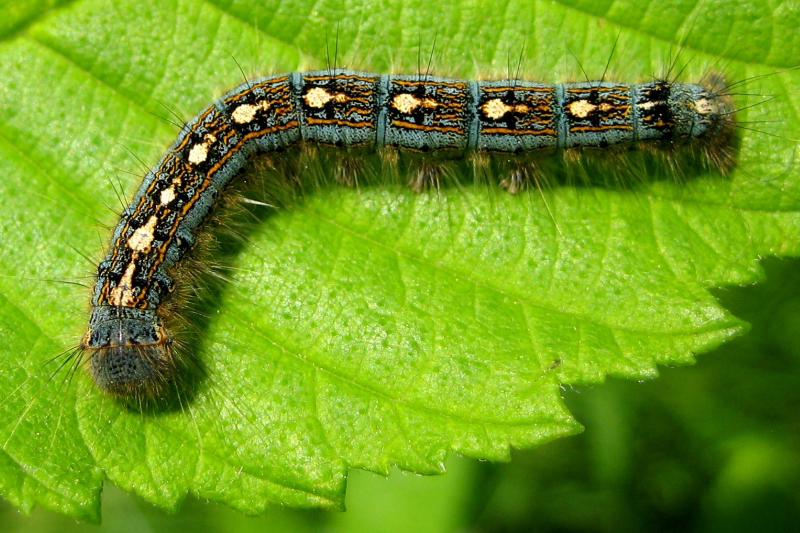By Pat Miller
Forest Tent Caterpillars in the Battle Lake Area
In addition to this information piece, the reader can find excellent information via the web by using one of the leading search engines, such as Google, under the topic Forest Tent caterpillars.
As you can already see, technically we are speaking about Forest Tent Caterpillars or Malacosoma disstria Hubner, if one really wants to be technical. They can be found over most of the U.S. and Canada wherever broadleaved trees, such as oaks, basswoods, aspen, ash, and birch, are prominent. Species that are normally left alone include red maple, and most conifers. As such, we are in a prime area for these “worms”. So, what should one know about them? Are they dangerous to humans, or to trees? Planes were used to spray them again, in parts of our county. Even a few of the lakeshore associations in our immediate area were directly involved in spraying again. In several areas many adjoining property owners organized and did what they could via spraying etc. So, what can or should be done about them?
For the most part, these “worms” are nothing more than a nuisance. They are not dangerous to humans, and in most cases, they are not even dangerous to healthy trees. These “worms” generally come and go in cycles of about 10 years, in which we can expect a two to three year period when they can be a serious nuisance, as was the case in much of our immediate area this past Spring. Even though the trees appear to be well stripped by these “worms”, in most cases the trees will grow a new set of leaves in the same season and survive just fine. However, if the infestations are heavy and do go longer than about three years for the same trees, and /or if the trees are stressed in other ways, such as with dry conditions and diseases, the trees may die, though that is quite rare. The trees are weakened by the infestations, and will not grow as fast during the years of heavy infestations. Does it pay to hire a plane and spray these “worms”? Is that harmful to the lakes? What can we as individuals do? Let’s get to some of these questions.
Probably the best thing for us is to have a fairly good understanding of the general life cycle of these “worms”, including knowing when to go after them and how to do it, if at all. These “worms“ first appear from egg masses in early to mid-May in our area. These egg masses were actually laid by moths the previous year–which is another part of their life cycle. After emerging from the egg masses, these “worms”, or caterpillars are very little, less than one-half inch in length, and they actively feed and continue to grow. In five to six weeks they will grow up to two inches in length. The most effective time for spraying is when they are less than one half inch in length. In those years of heavy infestation, it is not uncommon for these “worms” to strip other plants, such as shrubs, to find food, and that can result in significant damage.
In late June, in our area, the full-grown “worms”, or caterpillars search for protected places to spin silky cocoons. Often times, their cocoons can be seen on the sides of homes and other buildings. Within about two weeks of this, or generally by mid July, moths emerge from these cocoons. These moths are nocturnal in nature, though they are attracted to lights at night. They don’t live very long. Within about five days they will deposit from 100 to 350 eggs in gray masses on small twigs, before dying. The egg masses normally survive most winters, and emerge as caterpillars or “worms” the following Spring. As such, as a homeowner, one can be aware of the cocoons, and “sweep” them off the buildings and destroy them at that time. One can also watch for the egg masses and destroy them. By doing so, one would eliminate many of them for the upcoming season.
What about spraying the caterpillars prior to the time that they are less than one half inch in length. If the infestation is considered serious, and that involves very close observation, spraying can be very effective. A common insecticide used in spraying is commonly referred to simply as BT. The actual name is Bacillus thuringiensis. It is not harmful to fish or other wild life. It is used by West Central Airways of Fergus Falls, MN. BT has been used extensively in our general area for some time, including part of West Battle Lake, the entire north side of Ottertail Lake, and other lakes the past year. Again, timing is an important consideration, as well as the seriousness of the infestation. Also, while one part of a lake may be seriously infested , other parts of that same lake may be just fine. So, it could be a waste of money to spray the entire lake. One would have to have a fairly clear understanding of where the actual infestation is taking place, and act on it quickly, if necessary. As such, for the larger lakes, it would not usually be feasible to routinely spray the entire lake every year that there is a heavy infestation. The actual “lake” is not sprayed. Rather, it is the immediate adjoining property next to the lake. The approximate current cost for spraying is about $25 to $30 per acre depending on the number of acres to be sprayed.
In summary, forest tent caterpillars can be quite a nuisance especially during years of heavy infestation. Fortunately they seem to go in cycles. For the most part they are not harmful to humans or even to healthy trees. Having a general understanding of their life cycle is helpful. For those local areas that experience heavy infestations, spraying can be quite effective provided that it is done before they are less than one half inch in length. That does necessitate very close observation as to the size of the caterpillars and the specific area of infestation, as well as coordination with the local sprayers, such as West Central Airways in Fergus Falls, MN. They also need lead time in ordering the chemical and weather conditions must be considered. And, not all homeowners may be in agreement that spraying is even necessary. A few of the smaller lakeshore associations do coordinate spraying activities, but that is rare for the larger lakes. And, again, much more information may be found on the internet.

